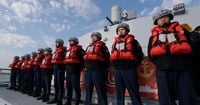On October 9, 2025, Taiwan’s Ministry of National Defense released a report that put the island’s escalating drone defense efforts front and center, underscoring a new chapter in the tense cross-strait relationship with China. The report, highlighted by the Aviation Week Network and widely covered by international outlets including the Associated Press, details an urgent push to train soldiers to shoot down drones and to acquire state-of-the-art anti-drone weapons systems. These initiatives are a direct response to a surge in Chinese drone incursions, particularly over Taiwan’s vulnerable outlying islands, which sit just a stone’s throw from the Chinese mainland.
For years, China has claimed Taiwan as its own, though the island continues to function as a self-governing democracy. The defense report, released Thursday, lays out a comprehensive strategy to counter the growing sophistication and frequency of Chinese drone operations. The plan is simple in concept but complex in execution: identify, track, and neutralize unauthorized drones as they approach Taiwanese airspace. This is no easy feat, especially given the rapid pace of drone and counter-drone technological development.
Major General Sun Li-fang, spokesperson for the Ministry of National Defense, captured the breakneck speed of this technological arms race. “Basically the drone development and anti-drone developments are very fast, and based on today’s situation, there’s different progress every day,” Sun said, as quoted by the Associated Press. “This is one of our key points in our military preparedness efforts.”
Taiwan’s outlying islands—such as Kinmen and Matsu—are on the front lines of this new kind of warfare. These islands, closer to the Chinese coast than to Taiwan’s main island, have become frequent targets of drone incursions. Soldiers stationed there are not only learning to shoot down drones in daylight but are also practicing night shooting, a testament to the round-the-clock nature of the threat. The defense ministry’s report makes clear that anti-drone preparedness is not just a technical challenge but a vital pillar of Taiwan’s broader military readiness.
Yet drones are only one piece of China’s so-called “grey-zone” tactics—a term for operations that pressure or intimidate without crossing the threshold into open warfare. According to the ministry’s report, China has woven drones into a wider strategy that includes regular Chinese Coast Guard patrols, the boarding of Taiwanese fishing vessels, and frequent, large-scale exercises by the People’s Liberation Army. These activities are designed to keep Taiwan off-balance, test its defenses, and send a clear message about China’s claims.
The situation escalated further in April 2025, when China launched a surprise military exercise around Taiwan, followed by a formal announcement of more extensive drills the next day. The ministry’s report describes these moves as part of a larger campaign: “The CCP has significantly increased joint combat readiness patrols, maritime and air blockades, joint firepower strikes,” the document states, referring to the Chinese Communist Party’s preparations for potentially establishing a blockade around Taiwan.
For Taiwan’s leaders, the message is clear: countering drones and other grey-zone threats is now a top priority. The defense ministry is not just investing in new hardware—it is also overhauling training, tactics, and coordination across the armed forces. The goal is to ensure that Taiwan can respond swiftly and effectively, no matter how the threat evolves.
International alliances play a critical role in this effort, and Taiwan has looked to the United States as its most important, if unofficial, security partner. The U.S.-Taiwan relationship, however, is shaped by shifting American political winds. In July 2025, Taiwan canceled a planned U.S. stopover by President Lai Ching-te, a decision widely seen as influenced by opposition from the Trump administration—a move that many analysts described as a diplomatic win for China. Former President Donald Trump had previously pushed for Taiwan to dramatically raise its defense spending, suggesting a target as high as 10% of GDP, a level far above what even the U.S. or its closest allies spend.
Despite the pressure, Taiwan’s Defense Minister Wellington Koo has charted a more measured course. On Wednesday, Koo reaffirmed a pledge to increase Taiwan’s defense budget to about 5% of GDP, up from the current 3%. “We will continue to strengthen our cooperative relationship through existing exchange mechanisms,” said Major General Liu Wenjing, director of Taiwan’s Strategic Research and Analysis Division, emphasizing the enduring focus on regional security and peace.
The partnership with Washington goes beyond political statements. In February 2025, Taiwan inked a $761 million contract with the United States to acquire a sophisticated air defense system specifically designed to counter the drone threat. This major investment reflects both the scale of the challenge and Taiwan’s determination to keep up with Chinese advances.
China’s drone incursions and military maneuvers are not happening in a vacuum. They are part of an ongoing campaign to test Taiwan’s resolve and probe its defenses, all while stopping short of outright conflict. The use of drones as a tool of intimidation has grown in recent years, with Chinese unmanned aerial vehicles buzzing over outlying islands, sometimes capturing footage or simply making their presence known. For residents and soldiers alike, the constant drone activity is a stark reminder of the island’s precarious position.
Meanwhile, Taiwan’s own capabilities are evolving. The Ministry of National Defense report highlights not just the procurement of foreign systems, but also efforts to develop homegrown technologies and strategies. Night shooting drills and rapid-response teams are just part of a broader push to modernize the military and adapt to a new era of hybrid threats.
The stakes are high. Any miscalculation or escalation could have consequences far beyond the Taiwan Strait, drawing in regional and global powers. Yet for now, Taiwan is betting that a mix of vigilance, technological investment, and international partnership can help it deter aggression and maintain its de facto independence.
Every day brings new developments in this high-stakes standoff. As Major General Sun Li-fang put it, “The development of drones and counter-drone measures is rapid, and every day brings new developments.” Taiwan’s strategy is to stay one step ahead, no matter how the game changes.
With tensions simmering and the world watching, Taiwan’s determination to defend its airspace—drone by drone—could well shape the future of cross-strait relations for years to come.




